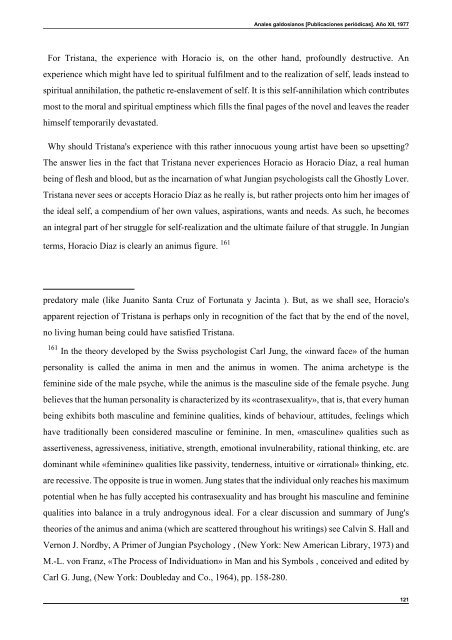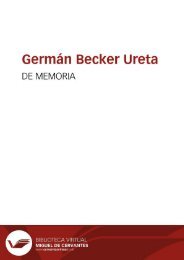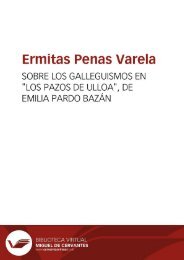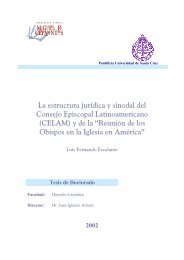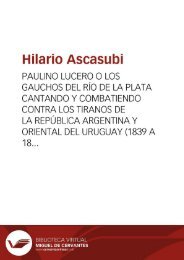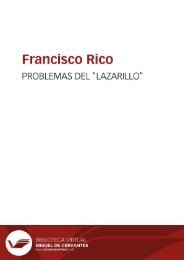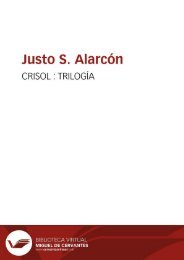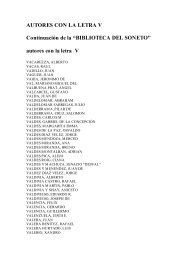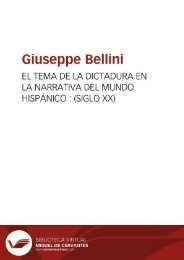Create successful ePaper yourself
Turn your PDF publications into a flip-book with our unique Google optimized e-Paper software.
Anales galdosianos [Publicaciones periódicas]. Año XII, 1977<br />
For Tristana, the experience with Horacio is, on the other hand, profoundly destructive. An<br />
experience which might have led to spiritual fulfilment and to the realization of self, leads instead to<br />
spiritual annihilation, the pathetic re-enslavement of self. It is this self-annihilation which contributes<br />
most to the moral and spiritual emptiness which fills the final pages of the novel and leaves the reader<br />
himself temporarily devastated.<br />
Why should Tristana's experience with this rather innocuous young artist have been so upsetting?<br />
The answer lies in the fact that Tristana never experiences Horacio as Horacio Díaz, a real human<br />
being of flesh and blood, but as the incarnation of what Jungian psychologists call the Ghostly Lover.<br />
Tristana never sees or accepts Horacio Díaz as he really is, but rather projects onto him her images of<br />
the ideal self, a compendium of her own values, aspirations, wants and needs. As such, he becomes<br />
an integral part of her struggle for self-realization and the ultimate failure of that struggle. In Jungian<br />
terms, Horacio Díaz is clearly an animus figure. 161<br />
predatory male (like Juanito Santa Cruz of Fortunata y Jacinta ). But, as we shall see, Horacio's<br />
apparent rejection of Tristana is perhaps only in recognition of the fact that by the end of the novel,<br />
no living human being could have satisfied Tristana.<br />
161 In the theory developed by the Swiss psychologist Carl Jung, the «inward face» of the human<br />
personality is called the anima in men and the animus in women. The anima archetype is the<br />
feminine side of the male psyche, while the animus is the masculine side of the female psyche. Jung<br />
believes that the human personality is characterized by its «contrasexuality», that is, that every human<br />
being exhibits both masculine and feminine qualities, kinds of behaviour, attitudes, feelings which<br />
have traditionally been considered masculine or feminine. In men, «masculine» qualities such as<br />
assertiveness, agressiveness, initiative, strength, emotional invulnerability, rational thinking, etc. are<br />
dominant while «feminine» qualities like passivity, tenderness, intuitive or «irrational» thinking, etc.<br />
are recessive. The opposite is true in women. Jung states that the individual only reaches his maximum<br />
potential when he has fully accepted his contrasexuality and has brought his masculine and feminine<br />
qualities into balance in a truly androgynous ideal. For a clear discussion and summary of Jung's<br />
theories of the animus and anima (which are scattered throughout his writings) see Calvin S. Hall and<br />
Vernon J. Nordby, A Primer of Jungian Psychology , (New York: New American Library, 1973) and<br />
M.-L. von Franz, «The Process of Individuation» in Man and his Symbols , conceived and edited by<br />
Carl G. Jung, (New York: Doubleday and Co., 1964), pp. 158-280.<br />
121


